Baba Yaga Music Home
» Encyclopedic Dictionary
» Costume Index
» Many-Colored-Land Costume Home
»
Making Circle Skirts without Patterns
This 'fan-fold' technique of cutting a circle skirt is a fast and low-stress way to cut circle skirts when you don't have a large table to support the fabric while you cut. And it is THE way to cut chiffon without losing your mind. You fold the fabric like a fan and then cut a twelve-inch line across the end.... and your 6-yard-hem circle is now ready to mount on a waistband and hang!
Why does this technique work? Almost every fabric stretches when cut on the bias, which is why you have to HANG YOUR SKIRT before hemming. Therefore, it DOES NOT pay to get hung up on exact cutting before the skirt has hung and stretched. Your perfect circles are going to turn into perfect trapezoids after gravity has its way.
Determine Fabric Requirements
| You are going to make half-circles from rectangles. You will need one rectangle for each half-circle.
This is the calculation for the Prime Measurement used to calculate both length and width of each rectangle: (skirt length + hems and seams + waist opening radius).
- Skirt length:Measure from where you want the top of the waistband to sit on your hip to where you want the hem to end. Take measurements at front, back, and both sides and use the longest one. For many women, the longest measurement will be from waist over a buttock to the floor.
- Hems and seams: Add 2" for hems and waistband seam.
- Waist Opening Radius:
- The radius of the opening for a 2-panel ( two half-circles) skirt will be 1/6 of your hip measurement.
- For 3+ panels, read the Create Your Waist-Opening Pattern step in the Making a Circle Skirt page to calculate radius.
The width for the rectangle is the Prime Measurement. If your fabric is wider than you need you DON´T have to trim it to size first.
The length of the rectangle is twice the Prime Measurement.
Example: The diagram on the left is the rectangle for each half of a 2-half-circle skirt for a woman with a 36" hip and a finished length of 34 inches.
- Skirt length: 34 inches
- Hems and seams: 2 inches
- Waist opening: 36/6 = 6.
Therefore, the Prime Measurement is 34 + 2 + 6, or 42. You will need a rectangle of fabric 42 inches wide and 84 inches long for each half-circle.
| | 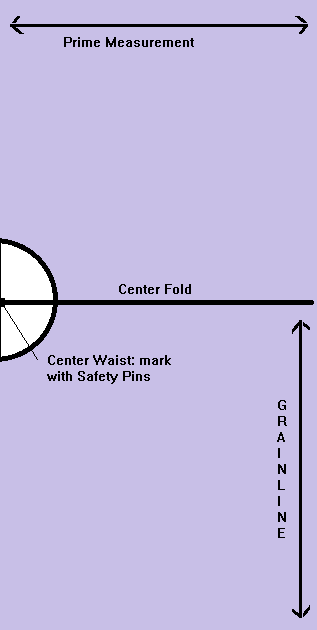
|
Mark the center waist
|
The picture at the above left has a circle marked in dotted lines in the middle of the left side (the eventual location of your waist opening) with a little mark in the middle of the circle. That is the midpoint of the long side. Take two safety pins (in case one comes out) and put them at the midpoint. No, you do not have to mark the circle. |
Fold Your Fabric Into A Fan
Fold your fabric in half across the short width, creating a square. .
- The pins marking the waist center should be in a corner (in the diagram, they are in the lower left corner).
- You now have a square.
|

|
Make your first diagonal fold.
- By bringing the corner marked UL (Upper Left) down to the corner marked LR (Lower Right), you will be folding along the line marked First Diagonal Fold Line.
- Make sure to start the fold from the center waist mark (safety pins). You don't want to lose track of the center-waist point in this or in subsequent folds - which is why you marked it with TWO safety pins.
- Be sure to make the side between UL and the waist-center mark line up with the line marked Center Fold.
- Pin ruthlessly to keep folded - or baste, if necessary.
|

|
| Now fold again on the line marked 2nd Diagonal Fold. As above, start the fold from the center waist mark and make the longest edges line up. You will not be able to line up the top edges; keep the shortest section on top. Fold as accurately as possible. |
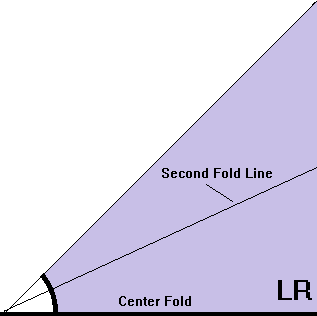
|
| Now make at least one more fold (for 16 sections). 2 more folds will give you 32 sections, and 3 more will yield 64. The more sections, the rounder the resulting half-circle will be. Remember to fold from the center waist mark and match the long edges as even as possible. Keep the shortest section(s) on top. Pin or baste or tack or secure with pony clamps ruthlessly as you fold to keep it folded. It doesn't have to be exact, but be as exact as you can be!
|
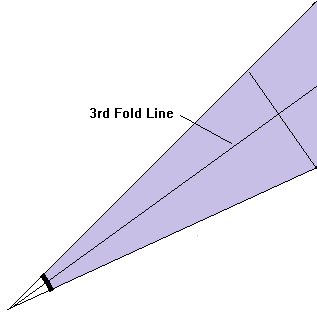
|
Mark and Cut the Raw Hem
Now make your fan as long as the Prime Measurement.
- Keep the shortest section on top;
- Mark the length of the Prime Measurement on both sides of the folded fan;
- then cut a slight curve between them (Cutting line is denoted with Xs in the picture.)
If you think you put pins where you'll be cutting, go slow and remove any suspicious lumps before cutting into them!
|
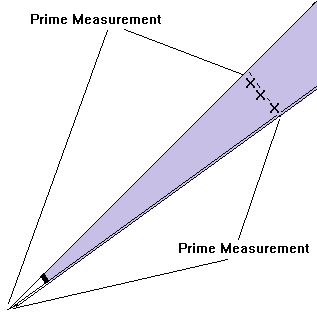
|
Mark and Cut the Waistline
|
Open your half circle up. As you can see, the multiple folds give a very circular effect while saving your sanity AND keeping the scraps as usable as possible! You are now ready to mark and cut your waist opening and sew your skirt together, starting [HERE].
|

|
Save Fabric by Overlapping
You can save fabric by cutting two half-circles from one piece of cloth, overlapping the patterns a bit. To do this, you need to mark the waist-center points for both half-circles before you start cutting.
- The first center-waist mark is a Prime Measurement from the short end of the fabric (in this case, 42").
- To determine where the waist-center point for the second piece is, use graph paper. Make two half-circle pieces to scale. Make a piece of fabric to scale. Place the half-circles on the fabric and you will be able to calculate where the waist-circle marks should be.
- On the real fabric, use safety pins to mark the center-waist mark, and then iron or baste a center-fold line for both semi-circles BEFORE you cut.
After you cut your first half-circle, straighten out your fabric and then make your first fold for the second half-circle on the center-fold line you marked/ironed before you started cutting. Proceed as above, folding on the diagonal as many times as you can before cutting and keeping the short side up. Folding for the second-half-circle will be a little more awkward than for the first one because of the various scrap ends attached, but go as carefully as possible and keep the cloth supported on a bed or table at all times. |
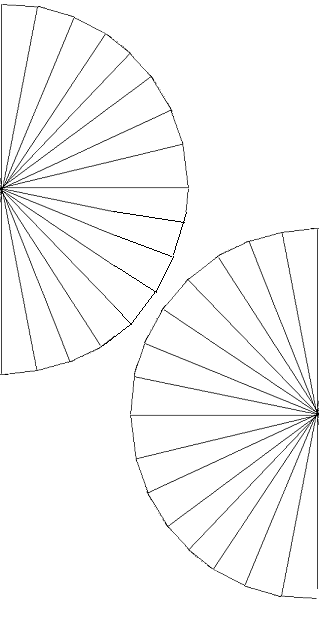
|
BabaYagaMusic.com
Maura Enright, Proprietor
Author: Maura Enright
©2012 - 2015 by Maura Enright
© means the content is copyrighted.
Your links to this content are much appreciated.
maura@babayagamusic.com







